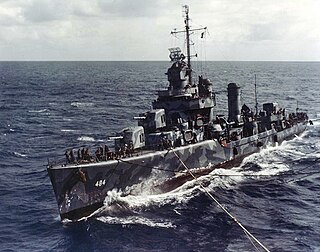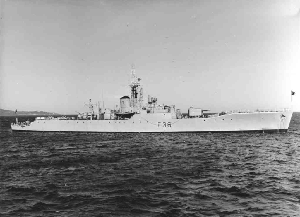
The Gato class of submarines were built for the United States Navy and launched in 1941–1943. Named after the lead ship of the class, USS Gato, they were the first mass-production U.S. submarine class of World War II.

The Centaur class aircraft carrier was the final iteration of the 1942 Design Light Fleet Carrier developed by the United Kingdom for the Royal Navy during the Second World War. They were designed in 1943 to operate higher-performance aircraft than the preceding Majestic-class aircraft carrier. Four ships were laid down in 1944-1945 and completed in 1953-1959. Rapid developments in carrier warfare and technology overtook the ships even as they were under construction, and the associated costs of modernization led to ships being completed to different specifications. Only the last ship, HMS Hermes (R12), was fitted as a modern fixed-wing carrier; she was also the last of the class to retire in 2017 as INS Viraat.

The Daring class was a class of eleven destroyers built for the Royal Navy (RN) and Royal Australian Navy (RAN). Constructed after World War II, and entering service during the 1950s, eight ships were constructed for the RN, and three ships for the RAN. Two of the RN destroyers were subsequently sold to and served in the Peruvian Navy (MGP). A further eight ships were planned for the RN but were cancelled before construction commenced, while a fourth RAN vessel was begun but was cancelled before launch and broken up on the slipway.

The Sargo-class submarines were among the first United States submarines to be sent into action after the Japanese attack on Pearl Harbor, starting war patrols the day after the attack, having been deployed to the Philippines in late 1941. Similar to the previous Salmon class, they were built between 1937 and 1939. With a top speed of 21 knots, a range of 11,000 nautical miles (20,000 km), and a reliable propulsion plant, along with the Salmons they were an important step in the development of a true fleet submarine. In some references, the Salmons and Sargos are called the "New S Class", 1st and 2nd Groups.

The Cleveland class was a group of light cruisers built for the U.S. Navy during World War II. They were the most numerous class of light cruisers ever built. Fifty-two were ordered, and 36 were completed, 27 as cruisers and nine as light aircraft carriers. They were deactivated within a few years after the end of the war, but six were converted into missile ships, and some of these served into the 1970s. One ship of the class remains as a museum ship.

The Oregon City class was a class of heavy cruisers of the United States Navy. Although ten ships of this class were planned, only four were completed – one of those as a command ship. The three ships completed as cruisers were in commission from 1946 to 1980, one having been converted to a guided missile cruiser (CG).

The Gleaves-class destroyers were a class of 66 destroyers of the United States Navy built 1938–42, designed by Gibbs & Cox. The first ship of the class was USS Gleaves. They were the destroyer type that was in production for the US Navy when the United States entered World War II.

The Mitscher-class destroyer was an experimental destroyer class of four ships that were built for the United States Navy shortly after World War II. Considerably larger than all previous destroyers, but smaller than their immediate predecessor, the experimental Norfolk, they would have been the first post-war destroyer class had they not been reclassified during construction as destroyer leaders (DL). Commissioned in 1953–1954, two of the class served until 1969, and were scrapped in the 1970s. The other two were converted into guided missile destroyers (DDG), served until 1978, and were sold for scrap by 1980.

The Farragut-class destroyer was a group of 10 guided-missile destroyers built for the United States Navy (USN) during the 1950s. They were the second destroyer class to be named for Admiral David Farragut. The class is sometimes referred to as the Coontz class, since Coontz was first to be designed and built as a guided-missile ship, whereas the previous three ships were designed as all-gun units and converted later. The class was originally envisioned as a Destroyer Leader class, but was reclassified as Guided-Missile Destroyers following the 1975 ship reclassification.

HMS Grenville was the second ship of this name to serve with the Royal Navy in the Second World War. Grenville and seven other U-class destroyers were ordered as part of the Emergency Programme. She was launched at Swan Hunter and Wigham Richardson Ltd., Wallsend-on-Tyne on 12 October 1942 and commissioned on 27 May 1943.

HMS Brighton was a Rothesay or Type 12I class anti-submarine frigate of the Royal Navy.

HMS Whitby was a Whitby-class or Type 12 anti-submarine frigate of the Royal Navy of the United Kingdom built by Cammell Laird and Co Ltd, Birkenhead. She was launched on 2 July 1954 and commissioned on 10 July 1956.

HMS Undaunted was a U-class destroyer of the British Royal Navy that saw service during World War II. She was later converted into a Type 15 fast anti-submarine frigate, with the new pennant number F53.

The Fargo-class cruisers were a modified version of the Cleveland-class cruiser design; the main difference was a more compact pyramidal superstructure with single trunked funnel, intended to improve the arcs of fire of the anti-aircraft (AA) guns. The same type of modification differentiated the Baltimore and Oregon City classes of heavy cruisers, and to a lesser degree the Atlanta and Juneau classes of light cruisers. Changes were made in order to reduce the instability of the Cleveland-class light cruisers, especially their tendency to roll dangerously. The main battery turrets sat about a foot lower and the wing gunhouses were lowered to the main deck. The medium (40 mm) anti-aircraft mounts were also lowered.

The Dealey-class destroyer escorts were the first post-World War II escort ships built for the United States Navy.

The Juneau-class cruisers were United States Navy light cruisers that were modified version of the Atlanta-class cruiser design. The ships had the same dual-purpose main armament as USS Oakland with a much heavier secondary antiaircraft battery, while the anti-submarine depth charge tracks and torpedo tubes were removed along with a redesigned superstructure to reduce weight and increase stability. Three ships were ordered and built, all completed shortly after World War II, but only Juneau remained active long enough to see action during the Korean War.
This page is based on this
Wikipedia article Text is available under the
CC BY-SA 4.0 license; additional terms may apply.
Images, videos and audio are available under their respective licenses.















